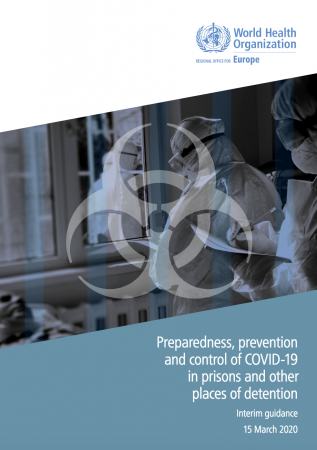
Features
Corrections Corner
Managing COVID-19 in Canadian prisons
On March 23, the World Health Organization (WHO) published an interim guidance on how to deal with coronavirus disease in prisons and other places of detention. Are we doing enough in Canada?
April 5, 2020 By Elina Feyginberg
 Photo: Getty Images
Photo: Getty Images The tough world of a correctional officer — a world normally comprised of being surrounded by murderers, sex offenders and drug dealers, a world where correctional officers run the risk of being assaulted, stabbed or possibly worse — has just became even more complicated and dangerous with the recent outbreak and rapid spread of COVID-19.
Like any other law enforcement officers, correctional officers risk their lives every day by virtue of their job. Working in constant close proximity with offenders, other staff and visitors — and all too often in a facility with poor air circulation and sometimes unsanitary conditions — creates a petri dish for easy growth of any virus or infection, especially for a virus that has been spreading as fast as COVID-19.
The first few cases of COVID-19, discovered in Ontario institutions during the first week of March, quickly made the news and the fear for all, including those who have family and friends employed within the correctional system, became very real. How quickly will this transmit in a place where physical distancing is not an option? Will the employer take the necessary measures to contain and prevent the virus from spreading? And are those measures even possible in a confined environment such as a prison?
On March 23, 2020, the World Health Organization (WHO) published an interim guidance on how to deal with coronavirus disease in prisons and other places of detention. The 15-chapter report includes recommendations on preparedness, contingency planning, training and education and the risk of communication. They include screening at the point of entry, minimizing non-essential visits, requesting that the staff with current travel history self-quarantine for 14 days, minimizing movement inside the institution and finding alternate measures for offenders to stay in contact with family while restricting institutional visits.
Public Safety Minister Bill Blair asked the prisons and parole boards on March 31 to consider early release for some federal inmates to mitigate the impact of COVID-19 behind bars, based on the recommendation of Justin Piche, a criminologist who runs the Criminalization and Punishment project at the University of Ottawa. This project aims to bring together students and professors from Carlton University and the University of Ottawa to “identify key issues to be the focus of criminological inquiry, develop collaborative research projects, as well as plan and carry-out related public education initiatives.” Piche argued that correctional services must engage in depopulation strategy in order to save lives. The union representing Canadian correctional officers rejected the notion, calling it a “complete disregard for public safety” in a CBC post.
After the discovery of the initial cases at Toronto South Detention Centre and the Hamilton-Wentworth Detention Centre, the Ministry of the Solicitor General was forced to place more restrictive measures in place, such as suspending personal visits, increasing screening procedures for everyone coming into the institution and more frequent cleaning within the institutions.
A number of institutions within Ontario have been criticized on several occasions by the courts and the media for overcrowding and “inhumane conditions,” such as three inmates per cell, inadequate healthcare and unsanitary conditions. Taking these issues into consideration, and with the recent cases of COVID-19 in Ontario institutions, the ministry has made the decision to have several non-violent offenders serving intermittent sentences return home and serve their sentences under house arrest. The ministry has also granted bail to a number of other non-violent offenders in an attempt to depopulate the jails and minimize the spread of the virus. This approach continues to create controversy within the community, fueling a heated debate on whether such approach is putting public safety at a greater risk or not.
Even though the government continues to adjust and review the measures put in place to contain and slow down the spread of the virus, recent refusals to work at several institutions — including one on April 2 at the Ottawa-Carleton Detention Centre, when correctional officers refused to work over lack of COVID-19 screening protocols — continue to raise concerns about whether these measures are enough.
As the virus continues to distract our country and ravage our economy, the heightened risk of the spread continues to exist within Canadian correctional system. And since containment and physical distancing in such places are nearly impossible to maintain, Canadian correctional officers continue to risk their health on a daily basis. We can only hope that the government is following the recommendations of WHO and making the health of essential correctional staff one of its top priorities.
Download the WHO interim guidance below:
Preparedness-prevention-and-control-of-COVID-19-in-prisons

Elina Feyginberg worked for Ontario Corrections between 2003 and 2012. She is currently working as an executive at an insurance firm and owns a corporate health and safety training company as well as a non-profit that promotes education for PTSD among correctional officers and first responders. Elina is continuing to further her education in the field of addictions and mental health.
Print this page